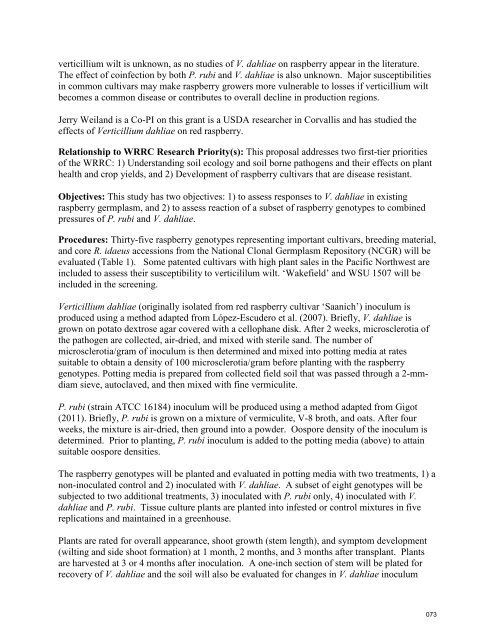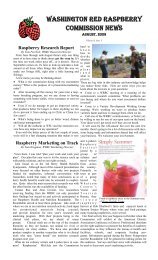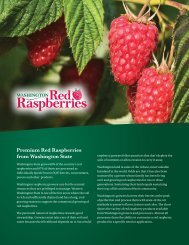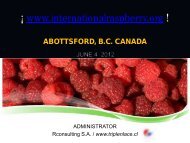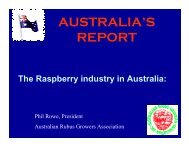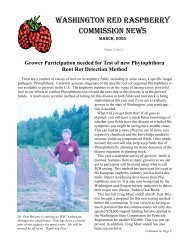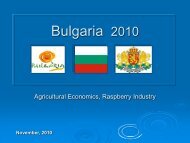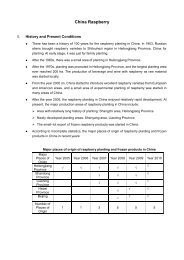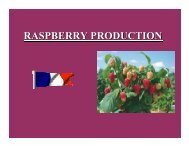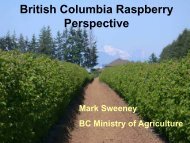2012 - Washington Red Raspberry Commission
2012 - Washington Red Raspberry Commission
2012 - Washington Red Raspberry Commission
Create successful ePaper yourself
Turn your PDF publications into a flip-book with our unique Google optimized e-Paper software.
verticillium wilt is unknown, as no studies of V. dahliae on raspberry appear in the literature.<br />
The effect of coinfection by both P. rubi and V. dahliae is also unknown. Major susceptibilities<br />
in common cultivars may make raspberry growers more vulnerable to losses if verticillium wilt<br />
becomes a common disease or contributes to overall decline in production regions.<br />
Jerry Weiland is a Co-PI on this grant is a USDA researcher in Corvallis and has studied the<br />
effects of Verticillium dahliae on red raspberry.<br />
Relationship to WRRC Research Priority(s): This proposal addresses two first-tier priorities<br />
of the WRRC: 1) Understanding soil ecology and soil borne pathogens and their effects on plant<br />
health and crop yields, and 2) Development of raspberry cultivars that are disease resistant.<br />
Objectives: This study has two objectives: 1) to assess responses to V. dahliae in existing<br />
raspberry germplasm, and 2) to assess reaction of a subset of raspberry genotypes to combined<br />
pressures of P. rubi and V. dahliae.<br />
Procedures: Thirty-five raspberry genotypes representing important cultivars, breeding material,<br />
and core R. idaeus accessions from the National Clonal Germplasm Repository (NCGR) will be<br />
evaluated (Table 1). Some patented cultivars with high plant sales in the Pacific Northwest are<br />
included to assess their susceptibility to verticililum wilt. ‘Wakefield’ and WSU 1507 will be<br />
included in the screening.<br />
Verticillium dahliae (originally isolated from red raspberry cultivar ‘Saanich’) inoculum is<br />
produced using a method adapted from López-Escudero et al. (2007). Briefly, V. dahliae is<br />
grown on potato dextrose agar covered with a cellophane disk. After 2 weeks, microsclerotia of<br />
the pathogen are collected, air-dried, and mixed with sterile sand. The number of<br />
microsclerotia/gram of inoculum is then determined and mixed into potting media at rates<br />
suitable to obtain a density of 100 microsclerotia/gram before planting with the raspberry<br />
genotypes. Potting media is prepared from collected field soil that was passed through a 2-mmdiam<br />
sieve, autoclaved, and then mixed with fine vermiculite.<br />
P. rubi (strain ATCC 16184) inoculum will be produced using a method adapted from Gigot<br />
(2011). Briefly, P. rubi is grown on a mixture of vermiculite, V-8 broth, and oats. After four<br />
weeks, the mixture is air-dried, then ground into a powder. Oospore density of the inoculum is<br />
determined. Prior to planting, P. rubi inoculum is added to the potting media (above) to attain<br />
suitable oospore densities.<br />
The raspberry genotypes will be planted and evaluated in potting media with two treatments, 1) a<br />
non-inoculated control and 2) inoculated with V. dahliae. A subset of eight genotypes will be<br />
subjected to two additional treatments, 3) inoculated with P. rubi only, 4) inoculated with V.<br />
dahliae and P. rubi. Tissue culture plants are planted into infested or control mixtures in five<br />
replications and maintained in a greenhouse.<br />
Plants are rated for overall appearance, shoot growth (stem length), and symptom development<br />
(wilting and side shoot formation) at 1 month, 2 months, and 3 months after transplant. Plants<br />
are harvested at 3 or 4 months after inoculation. A one-inch section of stem will be plated for<br />
recovery of V. dahliae and the soil will also be evaluated for changes in V. dahliae inoculum<br />
073


